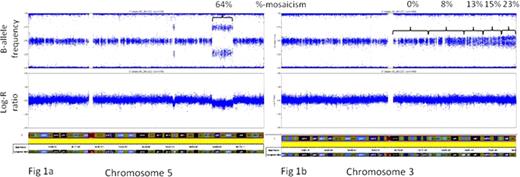Abstract
Abstract 1168
DBA is a congenital anemia that results from failure of adequate erythrocyte expansion from erythroid precursors, often associated with congenital physical abnormalities. Mutations of eleven ribosomal protein (RP) genes have been confirmed in association with DBA, with several other RP gene changes of uncertain significance reported in isolated cases. However, despite a series of sequencing studies in DBA including all of the RP genes, no genetic abnormality has been identified in ∼40% of patients, suggesting the possibility of additional genetic changes.
We performed SNP array genotyping on DBA blood samples without identified RP gene mutations to determine whether allelic loss of one or more RP genes, which would not be identified by sequencing, might be responsible for DBA in these patients.
We performed SNP array genotyping on 23 DBA probands, 5 parents, 1 affected and 1 unaffected sibling. Genomic DNA from peripheral blood mononuclear cells was hybridized to HumanOmni1-Quad BeadChips and copy number variants (CNVs) were identified using a hidden Markov model-based algorithm integrating signal intensity with SNP distribution. Regions of putative copy variation were queried for overlap with RP genes. Fractional mosaicism was estimated by modeling B-allele frequency data against mosaic models using an iterated, non-linear continuous distribution function regression model.
We identified regional monosomy of chromosomal regions containing RP genes with established relevance to DBA in 3 probands: 1) a 16 Kb deletion involving RPS26, 2) a 1.6 Mb deletion that includes RPS17, and 3) an 828 Kb deletion involving RPS19. The latter patient had macrocephaly with developmental delay and was not steroid responsive. The former two patients were steroid-responsive and lacked physical abnormalities.
In addition to constitutional copy loss at RP gene loci, we identified 3 examples of mosaic regional copy loss involving RP genes. Mosaicism is visualized by SNP genotyping as a symmetric splitting around 0.5 of the B-allele frequency plot into two distinct histogram peaks in regions of reduced signal intensity (Fig 1a & b). One patient, discussed in detail separately, demonstrated two discrete regions of mosaic loss on 5q in a region that includes RPS14 and is associated with 5q- MDS (Fig 1a). The monosomic fraction was estimated at 64% in mixed peripheral blood DNA. Similar analysis of DNA from sorted lymphoid and myeloid peripheral blood populations demonstrated near total monosomy in myeloid and disomy of these regions in lymphoid DNA. This abnormality was not found in either parent, further confirming somatic copy loss.
Two siblings evaluated from a family of 3 affected siblings demonstrated variable mosaicism of 3q, including the telomeric region containing RPL35a (Fig 1b). The degree of deletion was greatest at the telomeric end (23% at 187M-qter) and decreased approaching the centromere. DNA from a third sibling and father were not available; however no similar abnormality was detected in the mother. All siblings have modest neutropenia but lack physical abnormalities. None responded to corticosteroid therapy though two achieved spontaneous remission at 12 and 16 years of age. The father had a history of anemia and developed MDS progressing to AML at 44 years of age.
A third variably mosaic chromosomal abnormality was identified on the long arm of chromosome 15 in one proband. The involved region spans the entire long arm, and like the 3q abnormality, shows the highest fractional mosaicism at the telomere. This patient is also steroid-unresponsive and lacks physical abnormalities. RPS17, RPL4, RPLP1 and RPS27L all lie in the telomeric half of 15q.
We detected deletions of known or suspected DBA-related genes in a cohort of patients in whom no mutations could be found by RP sequencing. The rate of detection (6/23, 26%) suggests that deletions may explain a portion of patients in whom RP gene mutations cannot be identified. These data demonstrate the novel finding of chromosome-specific variable mosaicism in a hematologic disorder, a finding which suggests inheritance (3q-) or potentially acquisition (15q-) of a factor predisposing to regional chromosomal instability. Finally, these findings suggest the possibility of hematopoietic mosaicism as a determinant of remission from anemia seen in ∼20% of patients with DBA.
No relevant conflicts of interest to declare.
Author notes
Asterisk with author names denotes non-ASH members.


This feature is available to Subscribers Only
Sign In or Create an Account Close Modal